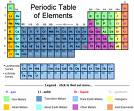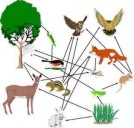 Click image
Click image
|
Introduction: An atom is usually comprised of a nucleus of protons (having a mass and a positive charge) and neutrons (having a slightly larger mass and no charge) with electrons (having a negligible mass and a negative charge). Each atom has an atomic number which is the same as the number of protons in its nucleus: hydrogen is 1, helium is 2, etc. All atoms of the same element have the same number of protons in the nucleus, but some may have different numbers of neutrons in the nucleus and are called isotopes. For instance, the isotopes of hydrogen are: protium with 1 proton, deuterium with 1 proton and 1 neutron, and tritium with 1 proton and 2 neutrons.
Radioactivity: Some isotopes are unstable and will sooner or later break up into smaller pieces (radioactive decay). For instance, tritium will decay into Helium-3 and give off a beta particle of radiation.
Halflife: While the moment at which a particular nucleus decays is random, a collection of atoms of a radioactive nuclide decays exponentially at a rate described by a parameter known as the half-life, usually given in units of years when discussing dating techniques. After one half-life has elapsed, one half of the atoms of the substance in question will have decayed. Many radioactive substances decay from one nuclide into a final, stable decay product (or "daughter") through a series of steps known as a decay chain. In this case, usually the half-life reported is the dominant (longest) for the entire chain, rather than just one step in the chain. Nuclides useful for radiometric dating have half-lives ranging from a few thousand to a few billion years.
The half-life of any nuclide is believed to be constant. In a material containing a radioactive nuclide, the proportion of the original nuclide to its decay product(s) changes in a predictable way as the original nuclide decays. Therefore, the relative abundances of related nuclides constitute a clock that measures the time from the incorporation of the original nuclide(s) into a material to the present.
 Click image
Click image
|
Dating: The uranium-lead radiometric dating scheme is one of the oldest available, as well as one of the most highly respected. It has been refined to the point that the error in dates of rocks about three billion years old is no more than two million years. One of its great advantages is that any sample provides two clocks, one based on uranium-235's decay to lead-207 with a half-life of about 700 million years, and one based on uranium-238's decay to lead-206 with a half-life of about 4.5 billion years, providing a built-in crosscheck that allows accurate determination of the age of the sample even if some of the lead has been lost. Potassium-argon dating involves electron capture or positron decay of potassium-40 to argon-40. Potassium-40 has a half-life of 1.3 billion years, and so this method is applicable to the oldest rocks. Rubidium-strontium dating is based on the beta decay of rubidium-87 to strontium-87, with a half-life of 50 billion years. This scheme is used to date old igneous and metamorphic rocks, and has also been used to date lunar samples. Radiometric dating can be performed on samples as small as a billionth of a gram.
 Click image
Click image
|
A dating technique used for historical or archaeological studies is the carbon-14 (C14) radiometric technique. Carbon-14 is a radioactive isotope of carbon, with a half-life of 5,730 years (very short compared with the above). It is continuously created through collisions of neutrons generated by cosmic rays with nitrogen in the upper atmosphere. The carbon-14 ends up as a trace component in atmospheric carbon dioxide (CO2). An organism acquires carbon from carbon dioxide during its lifetime. Plants acquire it through photosynthesis, and animals acquire it from consumption of plants and other animals. When an organism dies, it ceases to take in new carbon-14 and the existing isotope decays. The proportion of carbon-14 left when the remains of  the organism are examined provides an indication of the time since its death. the organism are examined provides an indication of the time since its death.
|


